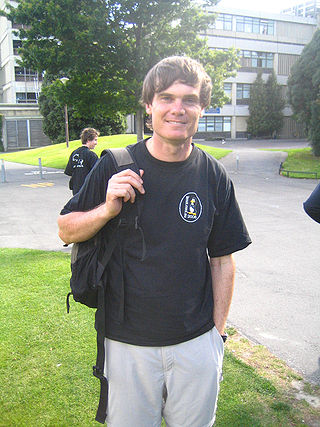
Andrew "Tridge" Tridgell is an Australian computer programmer. He is the author of and a contributor to the Samba file server, and co-inventor of the rsync algorithm.

An unmanned aerial vehicle (UAV), commonly known as a drone, is an aircraft without any human pilot, crew, or passengers on board. UAVs were originally developed through the twentieth century for military missions too "dull, dirty or dangerous" for humans, and by the twenty-first, they had become essential assets to most militaries. As control technologies improved and costs fell, their use expanded to many non-military applications. These include aerial photography, area coverage, precision agriculture, forest fire monitoring, river monitoring, environmental monitoring, policing and surveillance, infrastructure inspections, smuggling, product deliveries, entertainment, and drone racing.

UAV ground control station (GCS) is a land- or sea-based control centre that provides the facilities for human control of Unmanned Aerial Vehicles. It may also refer to a system for controlling rockets within or above the atmosphere, but this is typically described as a Mission Control Centre.
Slugs is an open-source autopilot system oriented toward inexpensive autonomous aircraft. Low cost and wide availability enable hobbyist use in small remotely piloted aircraft. The project started in 2009 and is being further developed and used at Autonomous Systems Lab of University of California Santa Cruz. Several vendors produce Slugs autopilots and accessories.

Arduino is an Italian open-source hardware and software company, project, and user community that designs and manufactures single-board microcontrollers and microcontroller kits for building digital devices. Its hardware products are licensed under a CC BY-SA license, while the software is licensed under the GNU Lesser General Public License (LGPL) or the GNU General Public License (GPL), permitting the manufacture of Arduino boards and software distribution by anyone. Arduino boards are available commercially from the official website or through authorized distributors.

Open-source robotics is a branch of robotics where robots are developed with open-source hardware and free and open-source software, publicly sharing blueprints, schematics, and source code. It is thus closely related to the open design movement, the maker movement and open science.
OBDuino is an open source trip computer design based on the Arduino platform. An OBDuino may be assembled and customised by an electronics hobbyist; it displays information such as instantaneous fuel economy, engine tuning parameters etc. on an LCD.
The Parrot AR.Drone is a discontinued remote-controlled flying quadcopter, built by the French company Parrot.

LibrePilot is a Free software unmanned aerial vehicle project for model aircraft aimed at supporting both multi-rotor craft as well as fixed-wing aircraft. Initially founded by David Ankers, Angus Peart and Vassilis Varveropoulos in late 2009, under the name OpenPilot, it was conceived as both a learning tool and to address areas the developers perceived were lacking in other small UAV platforms. In July 2015 OpenPilot, was forked to create LibrePilot.

A multirotor or multicopter is a rotorcraft with more than two lift-generating rotors. An advantage of multirotor aircraft is the simpler rotor mechanics required for flight control. Unlike single- and double-rotor helicopters which use complex variable pitch rotors whose pitch varies as the blade rotates for flight stability and control, multirotors often use fixed-pitch blades; control of vehicle motion is achieved by varying the relative speed of each rotor to change the thrust and torque produced by each.
Paparazzi is an open-source autopilot system oriented toward inexpensive autonomous aircraft. Low cost and availability enable hobbyist use in small remotely piloted aircraft. The project began in 2003, and is being further developed and used at École nationale de l'aviation civile (ENAC), a French civil aeronautics academy. Several vendors are currently producing Paparazzi autopilots and accessories.
ArduPilot:Copter previously named APM:Copter or ArduCopter is the multicopter unmanned aerial vehicle version of the open-source ArduPilot autopilot platform.
NuttX is a free and open-source Real-Time Operating System (RTOS) with an emphasis on technical standards compliance and on having a small footprint. Scalable from 8-bit to 64-bit microcontroller environments, the main governing standards in NuttX are from the Portable Operating System Interface (POSIX) and the American National Standards Institute (ANSI). Further standard application programming interfaces (APIs) from Unix and other common RTOSes are adopted for functions unavailable under these standards, or inappropriate for deeply embedded environments, such as the fork system call.
The PX4 autopilot is an open-source system designed for affordable autonomous aircraft, suitable for hobbyists operating small and remotely piloted aircraft. Originating in 2009, this project is continually evolving, with ongoing development and utilization at the Computer Vision and Geometry Lab of ETH Zurich. It also receives support from the Autonomous Systems Lab and the Automatic Control Laboratory. Currently, numerous vendors are manufacturing PX4 autopilots and associated accessories.

Salvius is an open source humanoid robot built in the United States in 2008, the first of its kind. Its name is derived from the word 'salvaged', being constructed with an emphasis on using recycled components and materials to reduce the costs of designing and construction. The robot is designed to be able to perform a wide range of tasks due to its humanoid body structure planning. The primary goal for the Salvius project is to create a robot that can function dynamically in a domestic environment.

3DR is an American company located in Berkeley, California that produces enterprise drone software for construction, engineering and mining firms, as well as government agencies.

Jani Hirvinen is one of the early Finnish IT-technology pioneers. Hirvinen is also one of the first ones developing small private sector professional level UAVs. He is among the top developers of the ArduCopter platform that - together with the included autopilot - changed the way drones are being flown all over the world. He is also the co-founder of famous international unmanned institutions ArduPilot, DIYDrones and DroneCode.
An autonomous aircraft is an aircraft which flies under the control of automatic systems and needs no intervention from a human pilot. Most autonomous aircraft are unmanned aerial vehicle or drones. However, autonomous control systems are reaching a point where several air taxis and associated regulatory regimes are being developed.











